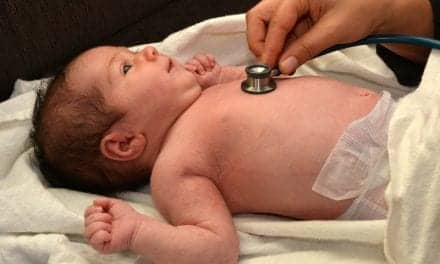Ninety percent of children with two specific genetic variations who exhibited wheezing when they caught a cold early in life later developed asthma by age 6, according to a new study by University of Chicago researchers that was published in the New England Journal of Medicine.
The genetic marker, a variation on chromosome 17, is common, researchers said, noting that half of the children in the study had one copy, and 25 percent had two. But the combination of the genetic variation plus the wheezing response to human rhinovirus (HRV) infection by children under age 3 was tightly linked to the development of asthma by age 6, researchers discovered.
Researchers analyzed data from two cohorts of children: the Childhood Origins of Asthma (COAST) birth cohort and the Copenhagen Prospective Study on Asthma in Childhood (COPSAC) birth cohort.
For the COAST study, 200 US newborns with at least one parent with respiratory allergies, a history of physician-diagnosed asthma, or both, were enrolled in between November 1998 and May 2000. Meanwhile, 297 Danish children born to mothers with a history of physician-diagnosed asthma were enrolled between August 1998 and December 2001 in Copenhagen as part of the COPSAC study.
The researchers first investigated the links between genes, wheezing with viral infection and asthma in the COAST group, in which they found significant interactions. Less than 30 percent of children in this group who lacked the asthma-related genetic marker were subsequently diagnosed with the disease, compared to 40 percent of children with one at-risk allele and 50 percent with two. Children who had two copies of the asthma-related genetic variation also had far more HRV-related wheezing illnesses.
When the researchers combined both factors, they found that only about 25 percent of children who had no wheezing illness from HRV developed asthma. About 40 percent of those who wheezed in the first three years of life but lacked the risk-related genes got asthma. That increased to nearly 60 percent for those with one copy of the asthma-related allele and to 90 percent for those with two copies.
“We found that the interaction between this specific wheezing illness and a gene or genes on a region of chromosome 17 determines childhood asthma risk,” said study author Carole Ober, PhD, the Blum-Riese professor of human genetics at University of Chicago. “The combination of genetic predisposition and the child’s response to this infection has a huge effect.”
Exactly how the genes and viral infection interact to cause asthma is unclear, researcher said. Two genes in the 17q21 region may play a role. One of them, known as ORMDL3, is the “most likely candidate,” according to Ober. Less is known about the potential function and impact of the second gene, called GSDMB.
Researchers recommend further study of the effects of the 17q21 genotype in response to HRV infection in respiratory epithelial cells and in the presence of concomitant bacteria. Such studies could shed additional light on the mechanism for the observed interaction, the authors wrote.








